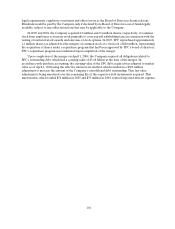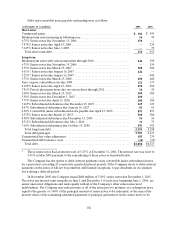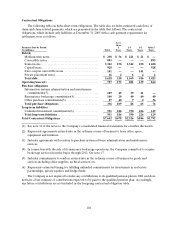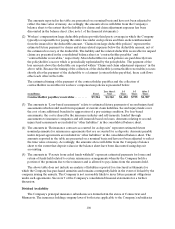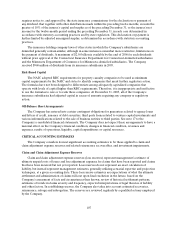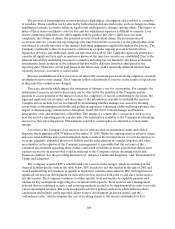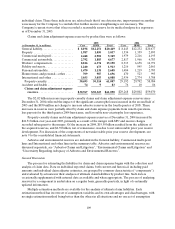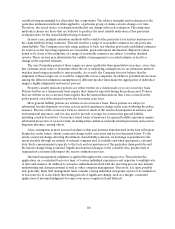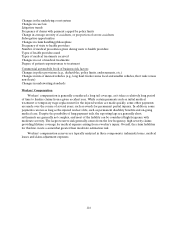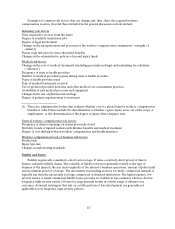Travelers 2005 Annual Report Download - page 123
Download and view the complete annual report
Please find page 123 of the 2005 Travelers annual report below. You can navigate through the pages in the report by either clicking on the pages listed below, or by using the keyword search tool below to find specific information within the annual report.111
The variables discussed above in this general discussionhave different impacts on reserve estimation
uncertainty for a given product line, depending on the length of the claim tail, the reporting lag, the impact
of individual claims and the complexity of the claim process for a given product line.
Product lines are generally classifiable as either long tail or short tail, based on the average length of
time between the event triggering claims under a policy and the final resolution of those claims. Short tail
claims are reported and settled quickly, resulting in less estimation variability. The longer the time before
final claim resolution, the greater the exposure to estimation risks and hence the greater the estimation
uncertainty.
A major component of the claim tail is the reporting lag. The reporting lag, which is the time between
the event triggering a claim and the reporting of the claim to the insurer, makes estimating IBNR
inherently more uncertain.In addition, the greater the reporting lag the greater the proportion of IBNR
claims to the total claim liability for the product line. Writing new products with material reporting lags can
result in adding several years worth of IBNR claim exposure before the reporting lag exposure becomes
clearly observable, thereby increasing the risk associated with pricing and reserving such products. The
most extreme example of claim liabilities with long reporting lags are asbestos claims.
For some lines, the impact of large individual claims can be material to the analysis. These lines are
generally referred to as being low frequency/high severity, while lines without this “large claim” sensitivity
are referred to as “high frequency/low severity”. Estimates of claim liabilities for low frequency/high
severity lines can be sensitive to a few key assumptions.As a result, the role of judgment is muchgreater
for these reserve estimates. In contrast, high frequency/low severity lines tend to have much greater spread
of estimationrisk, such that the impact of individual claims are relatively minor and the range of
reasonable reserve estimates is narrower and more stable.
Claim complexity can also greatly affect the estimation process by impacting the number of
assumptions needed to produce the estimate, the potential stability of the underlying data and claim
process and the ability to gain an understanding of the data. Product lines with greater claim complexity,
such as for certain surety and construction exposures, have inherently greater estimation uncertainty.
Actuaries have to exercise a considerable degree of judgment in the evaluation of all these factors in
their analysis of reserves. The human element in the application of actuarial judgment is unavoidable when
faced with material uncertainty. Differentexperts will choose different assumptions when faced with such
uncertainty, based on their individual backgrounds, professional experiences and areas of focus. Hence, the
estimate selected by the various actuaries may differ materially from each other.
Lastly, significant structural changes to the available data, product mix or organization can also
materially impact the reserve estimation process. The merger of TPC and SPC resulted in the exposure of
each other’s actuaries and claim departments to different products, data histories, analysis methodologies,
claim settlement experts, and more robust data when viewed on a combined basis. This impacted the range
of estimates produced by the Company’s actuaries, as they reacted to new data, approaches, and sources of
expertise to draw upon. It also resulted in additional levels of uncertainty, as past trends (that were a
function of past products, past claim handling procedures, past claim departments, and past legal and other
experts) may not repeat themselves, as those items affecting the trends change or evolve due to the merger.
This also increased the potential for material variation in estimates, as experts can have differing views as
to the impact of these frequently evolutionary changes. Events such as mergers increase the inherent
uncertainty of reserve estimates for a period of time, until stable trends reestablish themselves within the
new organization.


